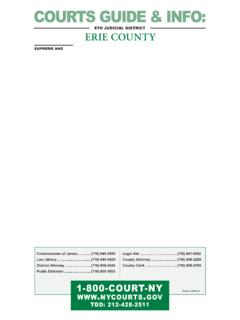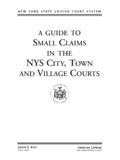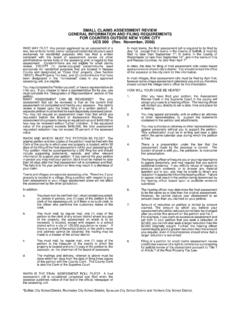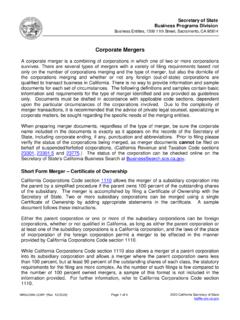Transcription of PRESS RELEASE
1 PRESS RELEASE . New York State Contact: Unified Court System Lucian Chalfen, Public Information Director Arlene Hackel, Deputy Director (212) 428-2500. Hon. Lawrence K. Marks Chief Administrative Judge Date: March 3, 2022. Chief Judge DiFiore, Senate and Assembly Judiciary Chairs Hoylman and Lavine Announce Introduction of Constitutional Amendment for Court Reform and Simplification Proposals Would Achieve Long-Overdue Reform of the New York Court System, Enhance Access to Justice for Low-Income Litigants and Underserved Communities Amendment Would merge Current Structure of 11 Different Trial Courts ALBANY, NEW YORK New York State Chief Judge Janet DiFiore, Senate Judiciary Committee Chair Brad Hoylman (D-Manhattan) and Assembly Judiciary Committee Chair Charles D. Lavine (D-Glen Cove) today announced the introduction of proposals to achieve long-overdue reform and simplification of the State's overly complicated court structure by merging the current 11 trial courts.
2 This would bring New York into line with our comparable sister states, such as California and Illinois, each of which has a single trial court; or Florida, which has two trial courts; or New Jersey and Pennsylvania, each of which has three. If enacted, the amendment would enhance access to justice for low-income, non-white and long-marginalized communities by untangling a labyrinthian system. The new structure would save millions in legal costs for low-income litigants, provide a greater platform for advancement and promotion of judges, and allow greater flexibility for judges to be assigned where needed. The proposal consolidates New York's major trial courts into the State Supreme Court, consolidates the trial courts of lesser jurisdiction (not including the Justice Courts) into a new statewide Municipal Court and permits the Legislature, once every ten years, to adjust the number and boundaries of the appellate Judicial Departments.
3 The current structure causes undue misery and expense for those moving through the system. For example, a woman seeking divorce in a criminally abusive relationship might need to travel to three separate courts even hiring three separate attorneys to deal with criminal charges, custody issues and divorce proceedings. New York State's trial court structure remains one of the most antiquated and convoluted in the country a system with 11 different trial courts that has not been updated in decades. While unintentional, the State's obsolete trial court structure has created barriers to justice that disparately impact our most vulnerable New Yorkers. We must modernize our outdated trial court structure in remedying these inequities and transforming our court system into a model of efficiency. I am thankful to Chairs Hoylman and Lavine for their leadership on this vital issue and look forward to working with them in our ongoing efforts to secure passage of a constitutional amendment to simplify the State's trial court structure, said Chief Judge Janet DiFiore.
4 Court reform is a long-overdue opportunity to fix our labyrinthine state courts and make our judicial system fairer, especially for low-income litigants. I look forward to working with the Chief Judge and my legislative colleagues on a consolidation proposal that reflects these goals, while diversifying the bench and respecting our unionized workforce. As we emerge from the pandemic, now is the time to address the deficiencies in New York's court system, said Senate Judiciary Committee Chair Brad Hoylman. "For decades, New York State has had one of the most archaic, complex and bureaucratic court systems in the nation. The result has been a two-tiered system that creates radically different experiences for litigants depending on their racial, economic and geographic backgrounds, and costs everyone time and money. We believe that the time for reform has finally come. Society demands that we seize this moment and change this structure to ensure equal access to justice for all New Yorkers.
5 I look forward to working with the Assembly and Senate members and the Chief Judge to push for first passage this year and advance the cause of equal justice for all, said Assembly Judiciary Chair Charles Lavine. Key Points: In the present system litigants and lawyers must navigate between multiple courts to secure complete relief. For example, these include: o Families in crisis, who may be forced to go from court to court for separate adjudication of related matters (domestic violence, custody and child support, matrimonial). o Children and others in guardianship cases, which may necessitate simultaneous proceedings in Surrogate's and Family Courts. o Injured individuals, large and small businesses, and State government agencies that must litigate cases simultaneously in Supreme Court and the Court of Claims whenever the State and a non-State actor are parties in a personal injury, medical malpractice, or commercial dispute.
6 O Practitioners, who must negotiate the many jurisdictional and procedural variations existing across 11 separate trial courts. These add to cost and delay. Court consolidation could save hundreds of millions of dollars annually by reducing litigation costs that result from lessened productivity, lost wages, attorneys' fees and related expenses. Implementation of any court systemwide improvement (technological, procedural, etc.) must be configured to the multiple types of courts, which, due to their different jurisdictions and provenance, are presently subject to varying statutory and regulatory procedures and systems. This adds greatly to the cost of such improvements. Simplification and reform would break down these barriers and allow for greater efficiency and coordination. A consolidated court structure will make it far easier for court administrators to redistribute personnel and other resources to meet court needs than the present system with 11 separate trial courts, each with its particular procedures, history, legal culture and, sometimes, legislative lobby.
7 A consolidated court structure will accelerate the ongoing diversification of the judiciary and provide greater access to opportunity for advancement for judges across the judiciary. Faced with the present constitutional cap on authorizing additional Supreme Court justices, court administrators have long resorted to extensive use of the power of temporary judicial assignment from the lower courts to meet court needs, especially in New York City. This results in an insufficient number of judges in those courts and leads to further delays. Court consolidation will provide the Legislature with a platform to review/rewrite the State's procedural statutes, which have not been recodified in 50 years or more, to reflect decades of new technology and case law development. The reforms would require an amendment to the State Constitution. For that to happen, both houses of the State Legislature must vote to approve the measure for two consecutive sessions.
8 Then it is put before the voters as a referendum. The Senate amendment introduced by Chairman Hoylman is S8424 and the Assembly amendment introduced by Chairman Lavine is A9401. Below are statements of support from current and former New York State judges, bar associations, legal and community advocates and the business community: Honorable Jeh Johnson on Efforts to Pass a Constitutional Amendment Reforming and Simplifying the New York State Court System I commend Chief Judge DiFiore for her continued commitment to equal justice in the New York State court system, featured front and center in her annual State of the Judiciary address delivered last week. In the report I issued in October 2020 on equal justice in our court system, I noted a second class system of justice and a dehumanizing and demeaning culture in the Housing, Family, Civil and Criminal courts of New York City. Rather than shy away from these criticisms, Judge DiFiore highlighted them, and is determined to do something about them.
9 But, the judicial branch of government cannot remedy these problems on its own. All three branches of New York State government must commit to a major overhaul of our over-burdened, under-resourced, archaic and incomprehensibly complex court system. The movement for court simplification, championed by Judge DiFiore and key leaders in the New York State Legislature, is an opportunity to address many of the inequities I. noted in my report. I offer the leaders of New York state government my help in achieving that goal.. Albany Times Union Op-Ed New York Needs Structure in the Courts Hon. Rolando T. Acosta, Presiding Justice, New York State Supreme Court, Appellate Division, First Department Hon. Randall T. Eng, Retired Presiding Justice, Appellate Division Hon. Carolyn Walker-Diallo, New York State Supreme Court Justice and Administrative Judge, Civil Court of the City of New York. New York State has rightfully earned its place as one of the progressive capitals of the nation.
10 New Yorkers have been at the forefront of some of the greatest movements for change over the course of our history from workers' rights to women's suffrage, from civil rights to criminal justice reform. But for decades, if not longer, that has not been true of needed reform of the court system. Right now, we are engaged in a struggle to transform our justice system to reverse generations of inequality and injustice. New York is today far behind many states in enacting long overdue reforms that we can and must pursue to ensure equal access to justice for all New Yorkers. Year after year, commission after commission and chief judge after chief judge have made the path to reform clear, but Albany has failed to act. The national demand for true justice reform starts with equal access to justice and that requires a court system, both Criminal and Civil, that operates equitably and efficiently for all. It is long past time to make these reforms a reality.
















